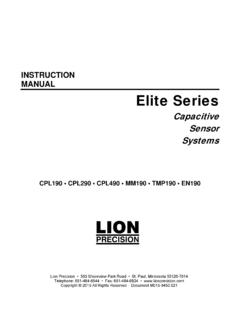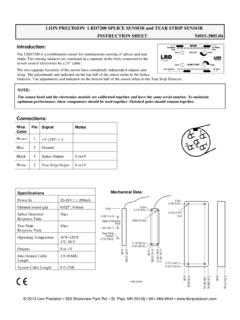Transcription of LA05-0022 † June, 2013 - Lion Precision
1 Lion Precision 563 Shoreview Park Rd. St. Paul, MN 55126 651-484-6544 2013 All Rights ReservedApplication NoteLIONPRECISIONLA05-0022 june , 2013 Shaft Runout Measurement with Noncontact Displacement SensorsApplicable Equipment:Capacitive and eddy-current displacement measurement : Measuring and monitoring shaft and bearing conditions in operating or test :Shaft runout is a common measurement especially for condition monitor-ing. Capacitive and eddy-current sensors provide useful non-contact measurement solutions with distinct advantages and , Eccentricity Lion Precision 563 Shoreview Park Rd. St. Paul, MN 55126 651-484-6544 2013 All Rights Reserved2 FundamentalsAccording to ASME/ANSI Methods for Performance Evalua-tion of Computer Numerically Controlled Machining Centers, runout is the total indicator reading (TIR) of an instrument measuring against a moving surface. This is usually a rotary motion and is measured for a full rotation.
2 This means the runout value is a combination of several types of error mo-tions, form errors, and form factors: shape of the shaft straightness of the shaft centering errors in the location of the shaft rela-tive to the axis of rotation (eccentricity), and errors in the axis of rotation itself which itself is a product of several factors: drive bearing performance machine structure drive alignment (tilt) measuring instrument errors (indicator or sensor) While techniques exist for refi ning a shaft runout measurement to just one or a few of these com-ponents, the purpose of this Application Note is to measure total runout with all of its contributing factors (except sensor er-rors). The techniques described here are intended to minimize or eliminate the sensor s contribution to the fi nal result. When properly applied, non-contact eddy-current and capacitive sensor measurements of shaft runout will produce results with negligible sensor errors.
3 Radial Shaft Runout Radial shaft runout is a measurement of radial displacement of the shaft surface as the shaft turns. Assuming a round shaft, contributing factors to Runout is the displacement of the surface of a rotating object. Non-round shafts will have signifi cant runout by defi Precision 563 Shoreview Park Rd. St. Paul, MN 55126 651-484-6544 2013 All Rights Reserved3radial runout include shaft straightness, drive/shaft alignment, bear-ing stiffness, and increasing runout as the bearings wear. Balance is a runout factor that is dependent on the relationships between speed and bearing stiffness and wear, and overall system stiffness. Radial shaft runout is generally used to indicate wear in the drive Shaft RunoutAxial shaft runout is a measurement of the axial displacement of the shaft as it rotates. This measurement is taken at the center of the shaft (on the rotary axis). Off-center measurements are called face runout in which the fl atness and squareness of the surface become contrib-uting factors to the measurement factors which are not of interest in most applications.
4 Axial shaft runout is primarily used for condition monitoring of the thrust ShapeBy the defi nition above, non-round shapes always have signifi cant run-out. An oval or hexagonal shaft which is rotating perfectly will still have signifi cant runout as the indicator responds to radial displace-ments of the shaft surface due to the shaft shape. This Application Note assumes that the shaft being measured is StraightnessRadial runout is affected by shaft straightness. If the shaft is bent, runout measurements will be dependent on the location of the mea-surement along the length of the shaft and the location and severity of the bend. If a shaft is fi xed at both ends ( between the drive and a gear box) the maximum runout will tend to be near the center. If the shaft is only fi xed at the drive end ( motors driving fans or propel-lers) the runout will tend to be worse at the fl oating end of the otherwise straight shaft may be mounted such that the center line of the shaft is not parallel with the axis of rotation.
5 In this case, runout will measurements will depend on where the measurement is taken along the runout is perpendicular to the axis of runout is measured at the center of rotation to prevent shaft end fl atness/squareness errors from affecting the straightness affects the runout Precision 563 Shoreview Park Rd. St. Paul, MN 55126 651-484-6544 2013 All Rights Reserved4 Synchronous and Asynchronous Shaft Runout ComponentsSome runout components such as shaft out-of-round-ness or a tilt in the drive will repeat at certain angular locations of the rotation; these are synchronous er-ror motions. Other shaft runout components such as bearing frequencies (runout due to out-of-roundness of rolling elements in the bearing) are cyclical but do not repeat at the same angular locations and are called asynchronous error motions. Real-TimeInstantaneous values of radial or axial shaft displace-ment can be measured and recorded at each angular location as the shaft rotates.
6 This provides a picture of the instantaneous displacements that contribute to the total runout measurement. This approach is used for balancing operations or to help identify specifi c causes of runout. These types of measurements require com-paratively sophisticated techniques and tools such as Lion Precision s Spindle Error Analyzer. This Application Note is focused on a single measurement of total shaft Shaft RunoutIn many circumstances, especially condition monitoring, the only value of concern is a single value indicating total shaft runout. This number is usu-ally an average or peak of multiple TIR readings over a period of time and multiple rotations. As bearings and other components wear, the total shaft runout will increase. In condition monitoring, a threshold value is set above which the system is shutdown and repair or rebuild is Measurements With Noncontact SensorsMeasuring shaft runout while in operation requires a non-contact sensor.
7 The types of sensors best suited to this measurement are capacitive dis-placement sensors and eddy-current displacement sensors (sometimes When using capacitive sensors, TIR can be displayed with the MM190 Meter displacements of the rotating shaft can help identify specifi c problems but is a more complicated Precision 563 Shoreview Park Rd. St. Paul, MN 55126 651-484-6544 2013 All Rights Reserved5called inductive displacement sensors). Capacitive or Eddy CurrentCapacitive sensors offer high Precision ; they work equally well with all conductive materials; they work well with small diameter shafts. But they require a clean environ-ment. Eddy-current sensors are work in wet, dirty en-vironments and can be mounted further away from the shaft. But they must be calibrated to a specifi c mate-rial, don t work as well with smaller shafts (< ), and are more noisy when used with magnetic steel shafts because of electrical runout (see details below in the Eddy-Current Considerations section).
8 Mounting the ProbeThese non-contact sensors consist of a probe (measure-ment head) which is connected via a cable to electronics that drive the probe and provide an output voltage propor-tional to the changes in distance between probe and the probe is mounted at a distance from the shaft approximately at the center of its measurement range. This allows for maximum excursions of the shaft in both directions to stay within the probe s functional range. After the probe is mounted, rotate the shaft slowly to check the range. Be sure the probe will not contact the shaft at its closest point and that it stays in range throughout the entire must stay insensor measurementrange and probe contactmust be ,Display, orComputerAny change of distance between the probe and shaft will be part of the shaft runout measurement. Therefore, it is important that the probe be rigidly mounted to prevent vibration or other external movements from displacing the probe relative to the Noncontact Displacement SensorsEddy-Current Noncontact Displacement SensorsLion Precision 563 Shoreview Park Rd.
9 St. Paul, MN 55126 651-484-6544 2013 All Rights Reserved6 Deriving Total Shaft RunoutThe shaft runout measurements from the non-contact sensor track the instantaneous displacements in real-time as the shaft rotates. This output must be conditioned to derive a single total runout measurement. The runout value can be a type of average value or a peak value. The specifi c method for creating a total runout value will depend on the application. Typically, a baseline runout value is set as well as a threshold above which the system needs operator attention. In this type of condition monitoring system, the units of measurement are not critical; whatever the units, the establishing of baseline and threshold values is the critical piece of the ValuesThe output values can be averaged over time by using some type of AC voltmeter. These are avail-able as discrete instruments or may be available in support software for a data acquisition system.
10 It is important to consider the meter s ability to measure at the rotational frequency of the ValuesPeaks of output values can be captured and the system can report the difference between the maximum and minimum peaks. This is a TIR (total indicator reading) measurement. Systems that capture these peaks have to be periodically reset to keep the value current should it decrease. If using Elite Series capacitive sensors for shaft runout mea-surement, the MM190 Meter and Signal Processing module can capture and display peak values. The MM190 also has Tracking TIR which captures peak values but allows the values to decay with time; this way, the displayed value is kept current without a reset being necessary, even when the runout is decreased. The MM190 is not an option for eddy-current (Peak-to-Peak) Total Runout can be measured with TIR (peak-to-peak) captures of the runout TIR(Changing Peak-to-Peak)Changing total runout can be measured with Tracking TIR option of the MM190 Precision 563 Shoreview Park Rd.




